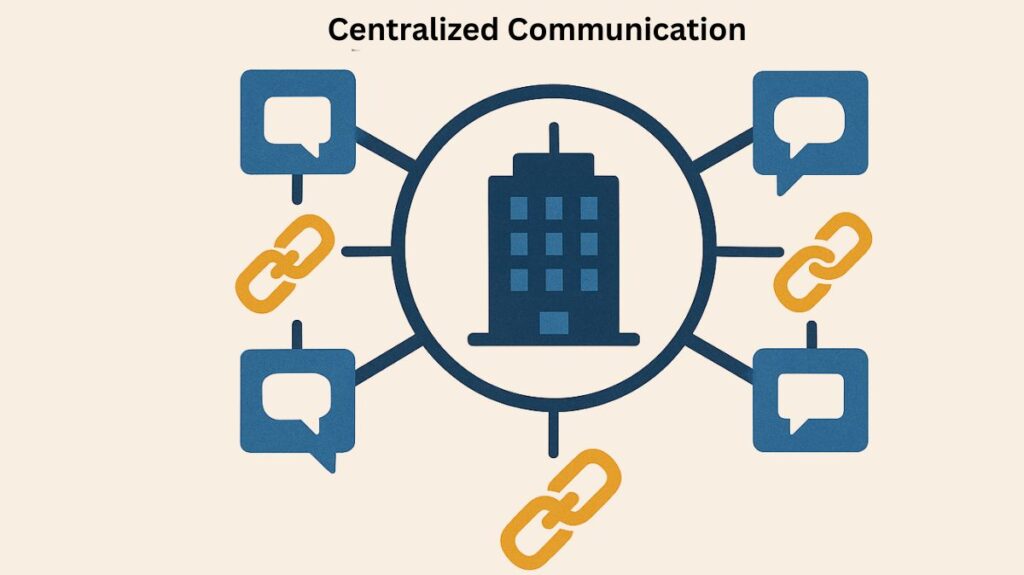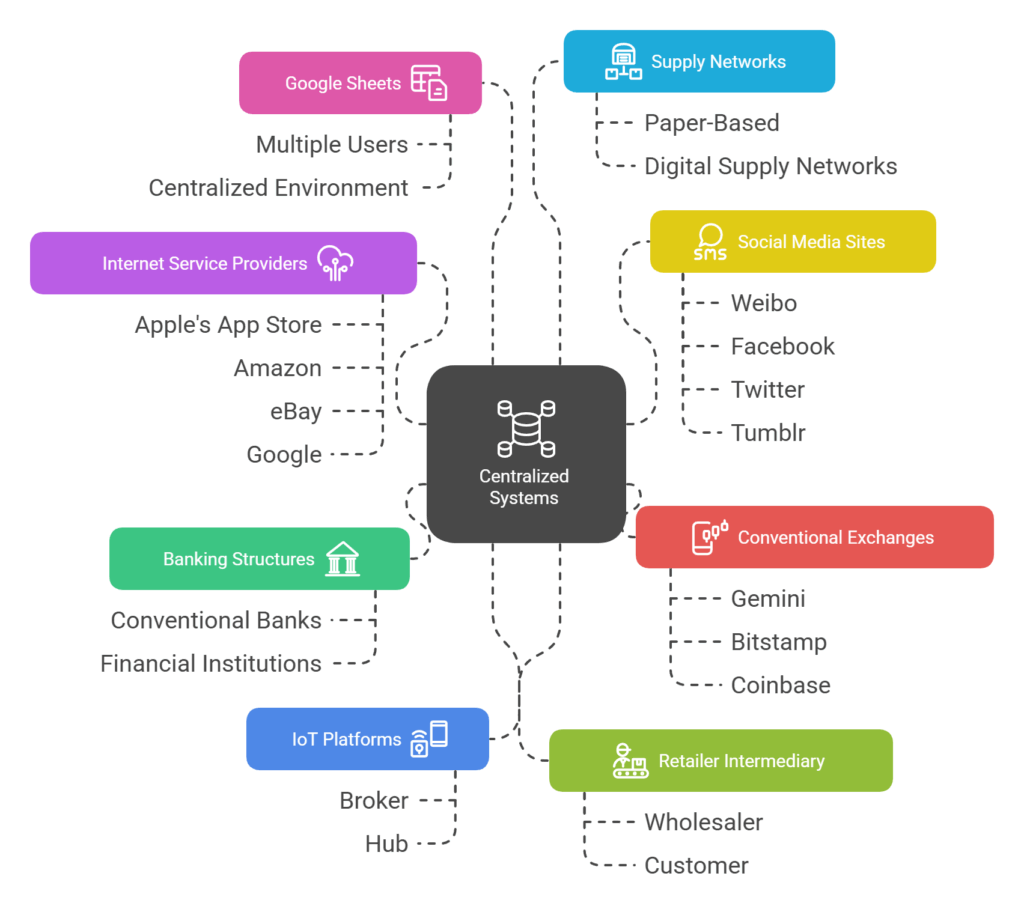Centralized communication

The term “centralized communication” describes a communication architecture in which the information and data flow within a system is managed and controlled by a single central authority. This contrasts with decentralized systems, in which numerous individuals share control.
Core Principle and Control
- In a centralized system, communication between all participants must go through a central authority. The “golden record” or the final version of the ledger is kept by this central organisation.
- Users entrust this central authority with the integrity of transaction verification, transaction clearing, and system state maintenance. This is very different from blockchain setups, which are made to function in a “trustless” way, which means that users don’t have to have faith in any third party.
- All records are kept in an instance by the central authority. In a regular banking system, for instance, the bank keeps track of accounts, debits and credits them, checks digital currency, and prevents double-spending.
Also Read About What Is The Decentralized Web (Web3) Meaning In Blockchain?
Features and How it Works
- Because a single administrator establishes the ledger’s rules, centralized systems are usually easier to design and manage. A centralized database is frequently involved.
- Because consensus techniques are simpler, performance is typically far better than in blockchain systems in terms of latency and throughput. For example, Bitcoin can only process about seven transactions per second, whereas Visa can process over 50,000.
- The central authority has direct management and control over data and processes.
- In centralized systems, security and privacy depend on the central organisation to apply best practices and supply essential security patches. Privacy may be easier to achieve when transparency and public verifiability are not system requirements. Like traditional client-server models, these systems send requests to servers, which process them. The server handles client-to-client communication.
Centralized Communication in Blockchain Contexts
- Private or consortium blockchains may exhibit centralized tendencies despite being decentralized.
- Despite decentralization, blockchain ecosystems may require centralized servers for user help, notifications, and party-to-party messaging.
- This is done to convey messages, match users (in exchanges), administer chat or customer support, and warn or confirm.
Examples of Centralized Aspects in Blockchain
Consortium and Private Blockchains
Often run by one person or organisation, giving them more network control.
Centralized Wallets
A third party manages funds and private keys in these blockchain-based wallets.
Possible Improvements
A smaller group of engineers or important contributors may influence blockchain protocol modifications, consolidating power. Binance, a centralized exchange, uses its servers for customer communication despite employing blockchain technology for transactions.
Decentralized App (dApp) Notifications
Some dApps send push notifications to users’ devices via central servers or APIs. Some blockchains use email lists or central chat rooms for validators. Exchanges and wallets send email confirmations through central systems.
Chat and Support
Even with on-chain transactions, centralized platforms handle user-to-user or user-to-admin interactions.
Order Matching
Decentralized exchanges can settle on-chain deals using central order books. Slack, Discord, and Telegram can help developers and validators coordinate node-to-node.
Advantages of Centralized Communication
- Easy construction and use.
- It uses fewer resources than completely decentralized alternatives.
- It enhances moderation and compliance control.
- Due to specialized resources, early setup costs may be reduced.
- Because just one controller participates in decision-making for transaction validation, they provide centralized consensus and peace of mind.
Also Read About Decentralized Consensus Build Secure Digital Economies
Disadvantages and Vulnerabilities
Single Point of Failure
The entire system may experience significant interruption if the central authority or its server is compromised (e.g., hacked) or goes down.
Mass Hacking and Manipulation
Hackers are likely to launch mass attacks on centralized repositories. It is possible to influence the central authority to divulge personal information.The establishment of a monopoly by the central government might result in greater prices for services or transactions, such as bank commissions for currency transactions.
Scalability Limitations
Centralized systems may experience scalability and performance issues, which renders them unsuitable for more complex ecosystems.
Lack of Transparency
Users must have faith that the owner is verifying each transaction and not changing historical data because transactions are frequently not made transparently.
Dependency on Trust
Attacks or malevolent intent have the potential to undermine the consumers’ unwavering trust in the service provider.
Limited User Control
Users frequently lack complete authority over their personal information.
Absence of Leadership Opportunities
Members are not given the chance to demonstrate their leadership abilities, which could result in a decline in performance.
Delays in Decision-Making
There may be a need for remote nodes to wait for the central controller to authorise choices, which raises security concerns and waiting times.
Censorship Risk
Communications may be blocked or monitored by the authorities.
Privacy Issues
The central authority may have access to sensitive information.
General Examples of Centralized Systems

- Conventional banking structures.
- Well-known internet service providers, such as Apple’s App Store, Amazon, eBay, and Google.
- Social media sites like Weibo, Facebook, Twitter, and Tumblr.
- The majority of Internet of Things (IoT) platforms regulate device interaction through a broker or hub.
- Conventional exchanges like as Gemini, Bitstamp, and Coinbase.
- A retailer serving as an intermediary between a wholesaler and a customer.
- Google Sheets, which has a centralized environment yet allows multiple users to edit.
- Paper-based, dispersed, or reliant on centralized, non-communicative digital supply networks in the real world.
